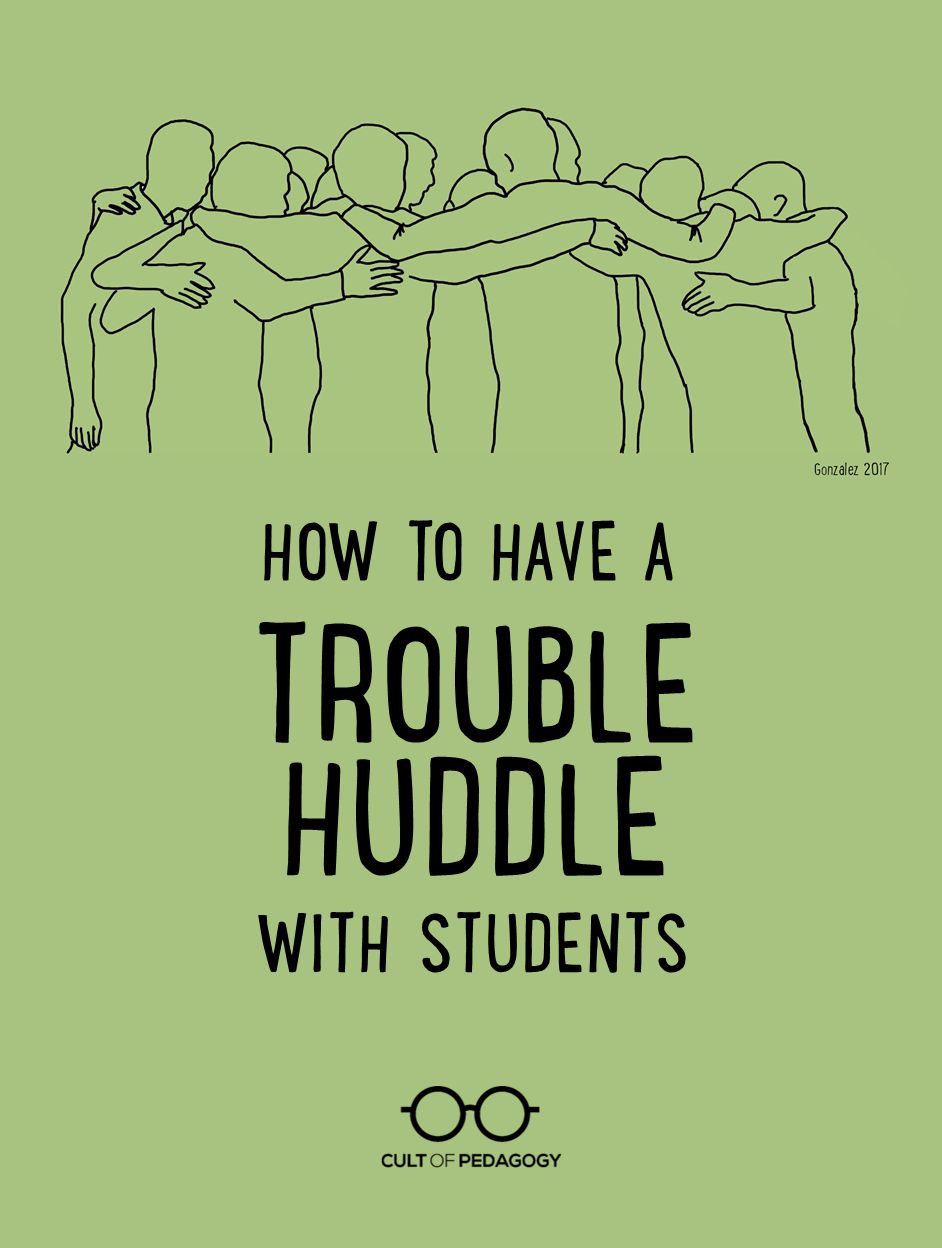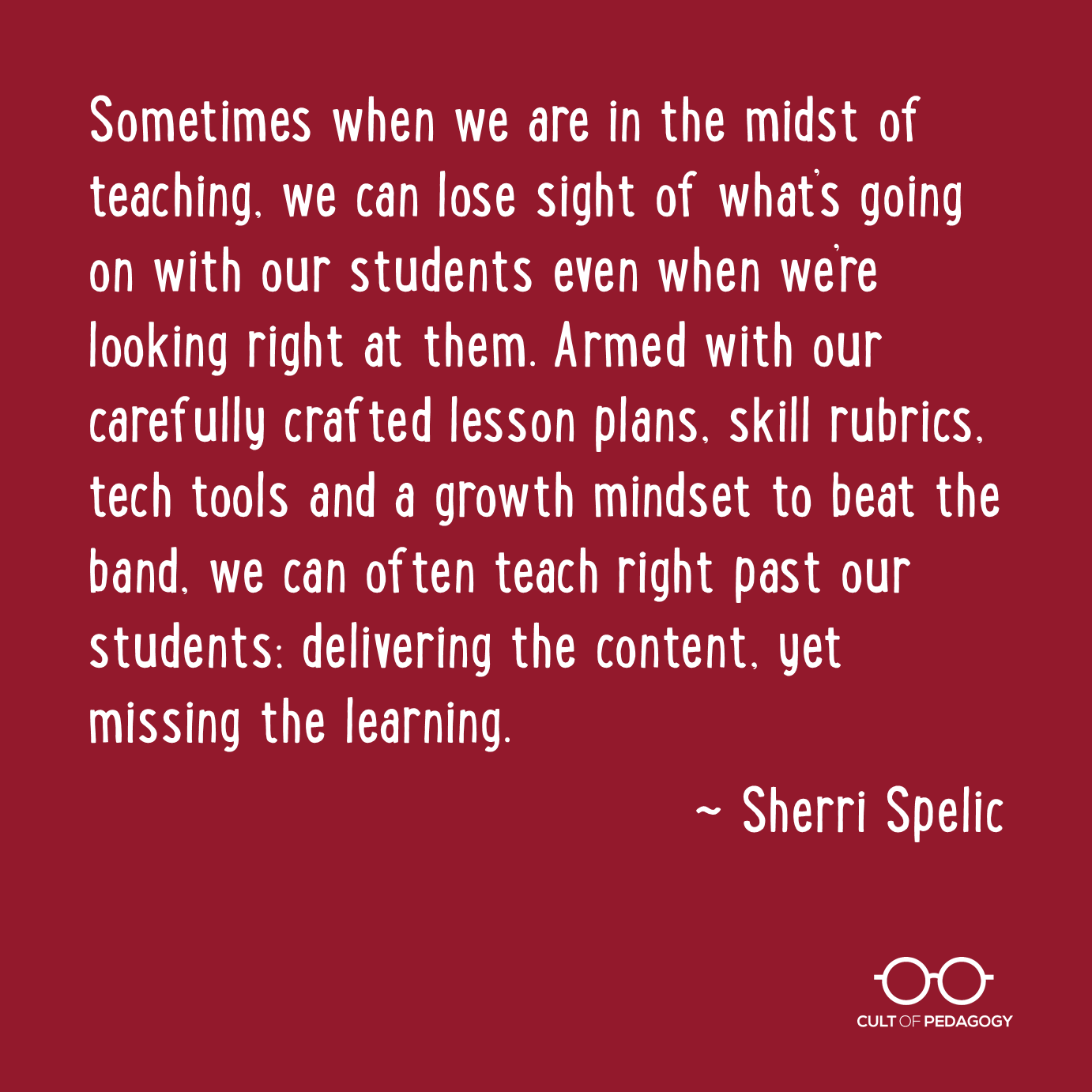What’s Going on Here? How to Have a Trouble Huddle with Students

I have admired Sherri Spelic’s work for years now and am thrilled to welcome her as a new contributor to Cult of Pedagogy. Be sure to check out her personal blog, Edified Listener, and the collaborative blog where she serves as editor, Identity, Education, and Power.
Once upon a time in the gym, I was busy setting up cones and markers for an exciting game I was going to introduce to my waiting first graders. They became loud and boisterous. I asked them to settle down for one minute more while I finished my preparations. They balked and stayed loud. I went over to them and asked this question:
“Boys and girls, what is it that you want me to understand with all this noise?”
“We want to play,” said one student.
“We want to have fun,” said another.
“And I’m keeping you from doing that, right?”
Several heads nodded.
I remember the conversation so clearly because at the time the question was a new one for me. Rather than shut things down, it opened up a genuine conversation. My students told me exactly what they needed and wanted. What we did after that was in direct response to their immediate needs. We experienced a brief but effective troubleshooting huddle—“Trouble Huddle” for short.
What is a Trouble Huddle?
Sometimes when we are in the midst of teaching, we can lose sight of what’s going on with our students even when we’re looking right at them. Armed with our carefully crafted lesson plans, skill rubrics, tech tools and a growth mindset to beat the band, we can often teach right past our students: delivering the content, yet missing the learning.
In my own elementary physical education classes, it is my students who consistently remind me that the content (skills, patterns, understandings) is not what they are there for, per se. Rather, they are there to have fun, be with their friends, and learn to do some things in the process. Understanding this helps me see my students more fully and also tap into their rich capacities for insight and discovery. One way I do this is with a trouble huddle.
With a trouble huddle, I allow my best laid plans to veer off the rails, stop the activity, and ask “What’s going on here? What seems to be the problem?” Some students are always quick to answer, usually to lay blame at a classmate’s feet. On occasion, I find that these moments can be wonderful teaching opportunities. As students offer their perspectives on what the difficulty is and how it might be overcome, we open the door to problem solving as a group.
A Sample Huddle
My students frequently run into difficulty when it comes time to create teams for a game. I provide some general parameters for the groups: they need to be co-ed, as evenly numbered as possible, and balanced in terms of skill and enthusiasm. If the process takes more than one or two minutes, I often call them in and ask, “What’s the problem?”
“The teams aren’t fair!”
“That team has all the good soccer players.”
I usually scan the group to look for signs of agreement among students.
Returning the issue to the members who raised concerns, I say, “What seems to be getting in the way of making fairer teams?” This question is useful because it helps students look for visible barriers.
It only requires one or two brave souls willing to share their observations: “Some people only want to be with their friends.”
“So what could be done to create fairer teams?”
Responses from students typically suggest how members might be switched between groups. Often, the players regarded as weakest may be directed to move to one team or another. Then I may ask, “Did ____ ask to move?”
Not surprisingly, the answer is usually “No.”
I may remind the group of a maxim they have heard many times previously: “Before you send someone else to do the thing that you don’t want to do, you go yourself. That’s being responsible.”
By this time, some students will inevitably ask if I will simply make the teams. “Sure, I could make the teams,” I say, “but what would you be learning?” and “Who’s playing the game, you or me?”
In the course of this conversation, not all students are equally engaged. Restlessness can spread quickly. Students often remind each other (loudly) that their actual goal is to play a game. The concrete problem-solving likely requires less than 30 seconds; I recommend timing them, if possible.
Then the games can begin.

Making It Work
In order for such conversations to be a success, I’ve found a few things to be particularly helpful:
- I like to deepen my questions to students about “what’s going on” by asking specifically what they observed and how it made them feel. This allows students to identify concrete behaviors and actions for us to consider when working towards solutions.
- My role is primarily to moderate the discussion, not to fix the problem.
- I listen and then paraphrase student responses. When I paraphrase what a student has said, it can serve both as a comprehension tool for group members as well as an affirmation for the speaker that their words have been heard and valued.
- I draw the group’s attention to our process by sharing what I notice about who is speaking and who is remaining quiet, which themes seem most important and for whom, or which feelings are coming up as we talk.
- When aiming for solution building, I ask students about their goals for the activity. This is crucial for achieving an outcome they can and will work with. As I frequently ask, “Who is playing the game? What kind of game do you want to have?” Group ownership of any solution makes a world of difference.
- In approaching these conversations it’s important to stay aware of how each unique group is able to respond to this kind of challenge. Keep it brief and concrete for younger grades and hold students accountable for respecting established group norms (i.e., raising hands to speak, listening without interrupting).
Worth the Time
Trouble Huddles may not be for daily use, but they are possible at every grade level. All school children are capable of reflection and many will surprise you with their insights and sensitivity when they are given a nurturing forum to do so. As I help guide the discussion, I have a unique opportunity to model the behaviors that lend themselves to positive group outcomes. I listen carefully, paraphrase regularly, invite hesitant speakers and welcome students’ questions. For younger students I may act out the behaviors we’re discussing in exaggerated form to help them see where the difficulties lie. We may laugh a bit then.
In the process I learn so much more about my students and how they think about things. Our troubleshooting conversations remind us that there is always more going on than just the activity itself. In many cases, I can hold up a mirror for the class members to see some of their behaviors and the effects they are having on others. At other times, I can acknowledge my own role in adding to or mitigating confusion.
Trouble huddles can eat up time, cost some extra emotional energy and resist advance planning. Done well, however, they can open up a world of learning possibilities for students and teachers alike. ♦
Join my mailing list and get weekly tips, tools, and inspiration—in quick, bite-sized packages—all geared toward making your teaching more effective and fun. You’ll also get access to my members-only library of free downloadable resources, including my e-booklet, 20 Ways to Cut Your Grading Time in Half, which has helped thousands of teachers spend less time grading!